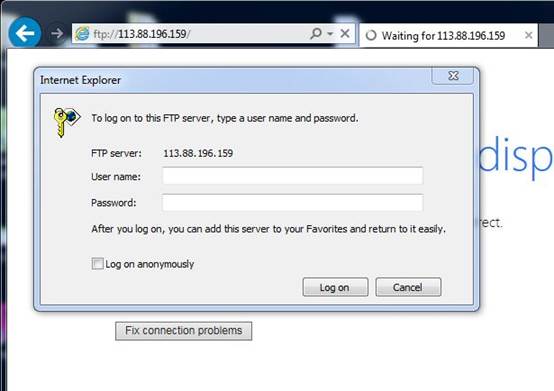
You will be presented with the ftp> prompt.įirst, you’ll probably want to get a listing of the files on the FTP server.
#GO FTP LOGIN PASSWORD#
If your FTP user account name and password combination are verified by the FTP server, you are then logged into the FTP server. Your password is not displayed on the screen. You will be prompted to enter your password for the FTP site. If your Linux user name and the FTP account name are different, type in the FTP account user name and then press Enter. This will use your Linux user name as the account name on the FTP server. If your account name on the FTP server is the same as your Linux user name, simply press the Enter key. Notice that the IP address of the site you’re connecting to is displayed, followed by your Linux user name. It then asks for the username of the account you are logging into. The wording of the greeting will vary from server to server. The FTP server responds with a welcome message. Use the sftp command, covered below, for transferring files over the internet. Please note: The 30-day money-back guarantee applies to our hosting plans it does not apply to most add-on services, such as domains, as mentioned above.Warning: You should only use the ftp command to connect to servers on a trusted local network.
#GO FTP LOGIN FREE#
You'll be free to transfer it or simply point it elsewhere. This fee not only covers our own costs, but it ensures that, even if you're dissatisfied with your experience at MyDomain, you won't lose your domain name. If you register a domain through MyDomain, please note there is a non-refundable $15 domain fee. Still, if you try us and decide that MyDomain just isn't for you, we think you should get your money back.

During the first 30 days, we'll refund your hosting fees in full. If you're not satisfied with MyDomain, we'll give you your money back. Click on the "OK" button to save the changes.The default value for the Connection Timeout is 30 seconds You can set the number of Maximum Retries, Retry Delay time, and the Connection Timeout by typing out the value you want it to be set to, or you can use the up and down arrows.From the Connection tab under the Options list select Use Favorite Settings Right-click on the Favorite and select Properties. From the SmartFTP Favorites, window select the Favorite for which you want to set the Connection Timeout.Select Favorites > Edit Favorites from the SmartFTP menu.
#GO FTP LOGIN HOW TO#
Options for SmartFTP How to set the timeout value?

Additionally, we recommend that you limit the number of reconnection attempts inside of your FTP client. To avoid the risk of being blacklisted, make sure that you keep your FTP client's login credentials up to date. This blacklist prevents the user from gaining access into MyDomain's FTP servers, even if the user begins using the correct login credentials. Here are a few options for you to consider:Īs a security precaution against malicious attackers, MyDomain's FTP servers will blacklist the IP address of users that have an excessive number of consecutive failed login attempts. Otherwise, select the subfolder or the files you intend to back up.
#GO FTP LOGIN DOWNLOAD#
Note: Click on the root folder ("/") if you wish to download all files on the server.

Password: FTP password (Your FTP account password).User: FTP username (Same as your hosting account username or the FTP account created).Protocol (Server Type): SFTP - SSH File Transfer Protocol.Example: (where is the primary domain).Host/Address: ftp.PrimaryDomain, where PrimaryDomain is your hosting account primary domain, set in your Domains dashboard.Enter the following information under the General tab: The Site Manager settings dialogue is displayed. SFTP uses SSH (secure shell) encryption to protect the data being transferred. While FTP is the traditional file transfer protocol, SFTP (Secure File Transfer Protocol) is an alternative to FTP that allows you to transfer files by adding a layer of security to the process. However, while changing the password of the root user, the account password won't be updated. By default, FTP root accounts are still created in a new account.


 0 kommentar(er)
0 kommentar(er)
